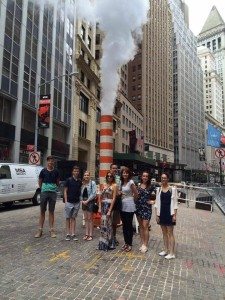If you live in NYC or have seen a movie or tv show set in NYC, perhaps you have seen large orange and white tubes coming out the sidewalk releasing enormous amounts of billowing white steam?
Or maybe you've noticed steam coming up through manhole covers. Your first reaction might be "Ummm...is that going to explode?"
Don't worry -- it's just New York City blowing off a little steam.
It's funny when you think of New York's iconic images, you think of yellow taxis, skyscrapers, and Times Square's LED billboards at night. You don't think of steam stacks.
Yet there is something about them that screams NEW YORK CITY.
In the daytime, steam stacks remind you of the heat and energy of a buzzing metropolis. Late at night, on a quiet street, there is something romantic about them.
If you have ever wondered what's up with that steam or just want to impress your friends with New York trivia, read on.
TIP: Learn more interesting tidbits and trivia about the city on one of our pay-what-you-wish walking tours. Our guides know a lot about what makes this city tick.
NEW YORK CITY'S STEAM SYSTEM
Underneath the streets of Manhattan, there are more than 100 miles of service pipes bringing steam to about 1,800 buildings.
Steam may seem like a primitive source of energy (think of steamboats and steam engines- we don't see those anymore).
But when New York's first power plant opened in 1882, steam from clean water greatly reduced the amount of soot created by individual coal-burning furnaces which were the primary source of heat at the time.
Steam is an environmentally friendly source of energy, and besides the obvious reasons (to heat and cool buildings), steam also plays a role in the sanitization of hospital equipment, the dry-cleaning industry, and believe it or not, the humidification process for priceless works of art in the city's finest museums such as the Metropolitan Museum of Art.
When you go see Van Gogh's "Starry Night" at the MoMA, think "Steamy Night"!
Pictured on the right is a group from one of our Lower Manhattan tours.
Our guests that day were thrilled to have a photograph with a steam stack -- proof they'd been to New York!
So where is that steam coming from? What is that steam about?
It isn't the steam that is running through the below-ground pipes.
Most of the time, the steam you see is the condensation that results from cooler water, like rain, falling through manhole covers coming into contact with the extremely hot pipes below street level.
You're more likely to experience this in cooler temperatures than in warmer ones.
Don't be afraid, it's not dirty smoke. It is, however, very hot so do not go too close.
TIP: To find out about New York weather year-round, see our post on temperatures.
The company that manages the steam pipe system, Con Edison, takes these leaks very seriously.
They bring out the orange and white stacks and place them over the leaks to contain the steam and direct it upwards and above traffic's eye level.
It also protects people from getting burned by the 350-degree vapor.
PIPE CORROSION AND EXPLOSIONS
Because the steam heat system has been used for well over a hundred years, pipes and equipment have on occasion caused chaos in the Big Apple.
In 2007, over forty people were injured, including one death, when an 80-year-old pipe exploded, sending large bits of debris along Lexington and 41st.
Below is a video of the aftermath of that massive explosion.
Despite the rare accidents, steam power is an energy-efficient system that offers many advantages in an urban setting.
It aids in reducing air pollution, as well as being cost-effective in comparison to every building having its boiler.
The system is costly, you won't see them in areas with small populations. But they make perfect sense in New York City with a population of over 8 million people.
STEAM STACKS AS ART

In 2016, Brooklyn-based artist Mark A. Reigelmän II built a tiny white house that he would place over the steam stacks, positioning the house so that the steam would be released through the house's chimney! Although he was unable to get a permit from Con Edison, he did what many artists do in New York and around the world. He committed the act of "Guerrilla Street Art", where an artist will place a piece of their art in a public place without any permission. Rarely does the artist get arrested but the artwork will be removed.
One famous example of Guerilla Art is Wall Street's Charging Bull, whose sudden appearance has a story too fantastical to believe. You can read the wacky history behind the bull in our post, The Charging Bull of Wall Street.
TIP: If you are interested in Street Art, we offer several Street Art tours in Manhattan and Brooklyn. See the various tours here.









